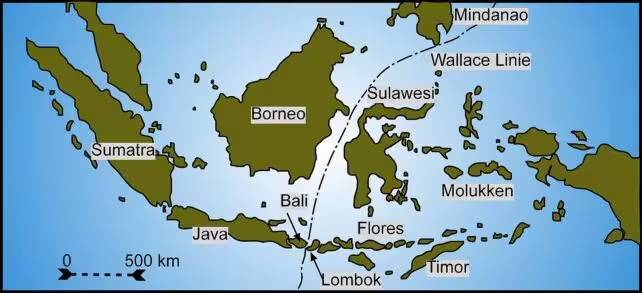5 Minutes
The Mysterious Divider: Origins of Wallace’s Line
Spanning the waters between Southeast Asia and Australia lies an invisible yet profound biogeographical barrier known as Wallace's Line. This hypothetical boundary creates a striking division between two vastly different animal kingdoms, separating the rich biodiversity of Asian species from their equally unique Australian counterparts. Despite close geographic proximity, very few animals ever cross this natural divide—a fact that continues to intrigue evolutionary biologists and ecologists worldwide.
Geological and Evolutionary Backdrop
The story of Wallace’s Line begins nearly 30 million years ago, when massive geological forces drove the Australian tectonic plate into the edge of the Eurasian plate. The collision generated a sprawling archipelago of islands and drastically altered ocean currents and climate patterns across the region. Over millions of years, this dynamic landscape became a crucible of evolution, isolating populations and driving the development of wholly distinct groups of animals on either side of the line.
To the west of Wallace's Line, in regions such as Indonesia and Malaysia, jungles teem with primates like monkeys and apes, large mammals such as elephants, tigers, and rhinoceroses. In stark contrast, the lands to the east—including New Guinea and Australia—are dominated by marsupials like kangaroos and koalas, elusive monotremes (egg-laying mammals such as the platypus), diverse birds like cockatoos, and unique species of reptiles and rodents. The faunal separation is so pronounced that only a handful of animal groups are found abundantly on both sides.

The Discovery and Legacy of Wallace’s Line
The concept of this invisible boundary was pioneered by 19th-century naturalist Alfred Russel Wallace, who, while exploring the Malay Archipelago, observed that animal species sharply differed between adjacent islands. He famously noted that even narrow water channels—such as the Lombok Strait, a mere 24 kilometers wide—acted as formidable barriers, preventing most species, including many birds and mammals, from crossing.
Wallace's observations formed the foundation for the idea now known as Wallace's Line, marking the frontier between Asian and Australian biogeographic realms. Independent of Charles Darwin, Wallace later developed his own theory of evolution by natural selection, eventually collaborating with Darwin and contributing to the birth of modern evolutionary biology.
What Makes the Line Impenetrable?
Wallace’s Line is not marked by any obvious geographic feature, but rather by deep ocean trenches like the Lombok Strait, which have persisted even through periods of low sea levels in Earth's past. These underwater chasms prevent many terrestrial animals from migrating between the continental shelves. Meanwhile, climatic differences—namely, the humid tropics of Southeast Asia versus the arid conditions of Australia—further reinforce the biological barrier, shaping distinct evolutionary pathways.
Notably, this division is not limited to mammals; it also impacts birds, reptiles, fish, and even microbes. Genetic studies have shown that many species on either side of the line are evolutionarily isolated, with little to no interbreeding or migration. Interestingly, even species capable of flying, such as most birds, typically respect the divide, suggesting that habitat and ecological preferences play crucial roles alongside physical geography.
Modern Research and Ongoing Mysteries
Recent large-scale analyses, including a 2023 study spanning over 20,000 vertebrate species, have further illuminated how the line influences biodiversity. The research suggests that Southeast Asian animal lineages evolved in a lush, interconnected archipelago, using islands as “stepping stones” to spread, while species on the Australian shelf adapted to much drier, more isolated environments and were less suited to colonizing tropical islands.
Nevertheless, the boundary is not absolute. Some highly mobile or adaptable creatures—such as bats, certain beetles, monitor lizards, and macaques—occasionally traverse the divide, revealing that the barrier can be more porous for some taxa. For scientists, this gradation transforms Wallace’s Line from a rigid border into a dynamic evolutionary gradient.
The Broader Significance of Wallace’s Line
The enduring concept of Wallace’s Line continues to influence how scientists interpret evolutionary history, biogeography, and conservation strategies. According to historian Jane Camerini, “Darwin's and Wallace's mental and actual maps were the table on which the evolutionary scheme was played out, comparable in importance to the geological time scale.” The idea behind this invisible line, initially sketched by Wallace over a century ago, has provided a crucial lens through which the complexities of animal evolution, species distribution, and the impact of geological forces are better understood today.
Conclusion
Wallace’s Line remains one of biology’s most compelling natural boundaries—one that highlights the interplay between geology, climate, and evolutionary history in driving the world's extraordinary diversity. As research continues, our understanding of this invisible divide evolves, offering fresh insights into the processes that shape life on Earth and reminding us of the delicate links between geography and biodiversity.



Comments